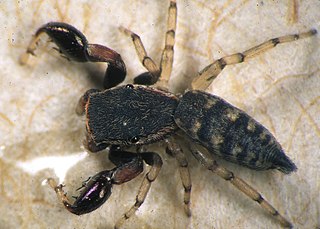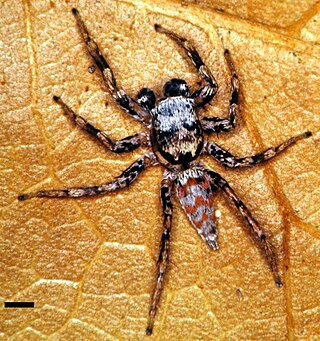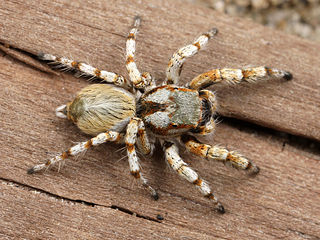
Bagheera is a genus of jumping spiders within the family Salticidae, subfamily Salticinae and subtribe Dendryphantina. The genus was first described by George Peckham & Elizabeth Peckham in 1896. The name is derived from Bagheera, a character from Rudyard Kipling's Jungle Book.

Zygoballus is a genus of jumping spiders found in North and South America.

Euophryini is a tribe of jumping spiders. It has also been treated as the subfamily Euophryinae.
Emertonius is a genus of spiders in the jumping spider family Salticidae.

Hyllus nigeriensis is a species of jumping spider in the genus Hyllus that is endemic to Nigeria. It lives in rainforest. The spider was first described in 2012 by Wanda Wesołowska and G. B. Edwards. A medium-sized spider, it typically has a cephalothorax 4.1 mm (0.16 in) long and an abdomen 4.0 mm (0.16 in) long. The abdomen is reddish-brown and narrower than the light brown carapace. Originally tentatively allocated to the genus Brancus, the species was allocated to Hyllus in 2022. Only the female has been described.

Hyllus remotus is a species of jumping spider in the genus Hyllus that is endemic to Nigeria. It lives near rivers. The female of the species was first described in 2011 by Wanda Wesołowska and Anthony Russell-Smith. The male has not been identified, which means that the species is only tentatively included in the genus. It is large, with a brown carapace typically 2.9 mm (0.11 in) long and an abdomen 4.2 mm (0.17 in) long. The spider is brown and brownish-grey with a white pattern on its back. It is similar to Hyllus plexippoides, except for its longer seminal ducts and the way that the gonopores are positioned.

Hyllus rotundithorax is a species of jumping spider in the genus Hyllus that is endemic to Tanzania. It lives near rivers. The spider was first described in 2000 by Wanda Wesołowska and Anthony Russell-Smith. The spider is large, with a brown carapace 5.8 mm (0.23 in) long and an abdomen 6.8 mm (0.27 in) long. The species has a distinctive rounded thorax, after which it is named, and a long thin embolus. Only the male has been identified.
Junxattus is a monotypic genus of southeast Asian jumping spiders native to Sumatra. It contains the single species, Junxattus daiqini, first described by Jerzy Prószyński and Christa Deeleman-Reinhold in 2012. The genus was placed in the subfamily Euophryinae, the equivalent of the tribe Euophryini.

Habronattus icenoglei is a species of jumping spider. It is found in the southwestern United States and north-central Mexico.
Habronattus ballatoris is a species of jumping spider. It is found in the United States.

Cheliferoides segmentatus is a species of jumping spider in the family Salticidae. It is found in a range from the United States to Guatemala.

Hyetussa complicata is a species of jumping spider in the family Salticidae. It is found in the United States.

Phidippus carneus is a species of jumping spider in the family Salticidae. It is found in the United States and Mexico.
Hyetussa alternata is a species of jumping spider in the family Salticidae. It is found in the United States.

Paramaevia michelsoni is a species of jumping spider in the family Salticidae. It is found in the United States.
Habronattus sabulosus is a species of jumping spider in the family Salticidae. It is found in the southeastern United States.

Habronattus amicus is a species of jumping spider in the family Salticidae. It is found in the United States.

Zygoballus minutus is a species of jumping spider in the genus Zygoballus that was first identified in Guatemala. The spider has also been found in Mexico, and the distribution may extend across Central America. Zygoballus minutus was first described by George and Elizabeth Peckham in 1898. It is a small spider, which is recalled in the name, which is the Latin for small, ranging in length between 3.5 and 4 mm. The male is distinguished by bands of white hair on the abdomen while the female has a pattern of streaks and bands. The palpal bulbs, which are reddish-brown on the male and yellow on the female, are also a distinguishing feature from other species in the genus.
Spadera is a genus of jumping spiders containing the single species, Spadera unica. It was first described by George and Elizabeth Peckham in 1894, and has only been found in Madagascar.











